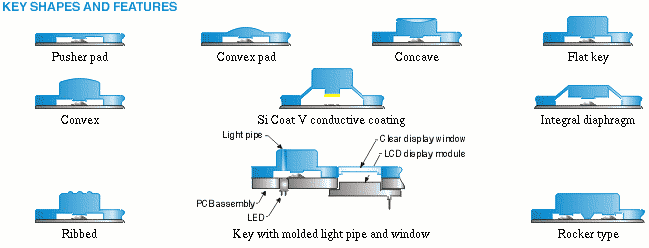 Silicone molded keypads made at SiTech are used in countless devices from aviation equipment to medical. The design of a tactile keypad is simple but elegant and understanding how it works will greatly help the design and outcome of your silicone keypad. The first step is to understand how the keypad can be tactile and what gives it it’s spring like mechanics. The next is to understand the force curve of the key itself. And lastly you should understand the life of the key and what causes it to wear over time.
Silicone molded keypads made at SiTech are used in countless devices from aviation equipment to medical. The design of a tactile keypad is simple but elegant and understanding how it works will greatly help the design and outcome of your silicone keypad. The first step is to understand how the keypad can be tactile and what gives it it’s spring like mechanics. The next is to understand the force curve of the key itself. And lastly you should understand the life of the key and what causes it to wear over time.
Acting just like a spring, a tactile key when pressed down pushes back with a force. When this key is released it returns to its neutral position. This is due to the webbing that connects the key to the mat of the silicone keypad. A typical design for the webbing is a 45-degree web angle, and a web thickness of 0.020”. The height of the web is also important. It should equal the distance of travel the keypad needs to make which is called the stroke.
The force curve of a tactile silicone key is made up of a couple different variables. First at the top of the curve you have the actuation force. The actuation force is the force required to collapse the membrane of a silicone key. Next you have the Contact force. The contact force is the amount of force required to maintain the closure of the silicone key. With these two forces, you are able to calculate a snap ratio. The formula for determining the snap ratio as followed: (Actuation Force – Contact Force) / Actuation Force. This ratio is what gives the keypad a tactile response or more simply put the snap feeling. The last force to determine is the return force. This is the force created by the keypad’s webbing as it returns to its neutral position. These forces are all mostly determined by the design of the webbing. Different variations in the thickness, angle and travel will give different forces across the board.
It is also important to understand the silicone keypads web life. The webbing of a silicone keypad will see degradation over time. This is due to continually pressing the key and letting it return. After time, the webbing will weaken, causing the actuation force to lessen, and the tactile response will weaken. Here at SiTech we offer a cycle life of over 1 million actuation cycles.
If you are looking for more information about Tactile Response, we have a mechanical design guide, and technical facts sheet listed on our website. If you would like to speak with our Engineer or submit a part for quote, you can call us at 757-887-8488 or submit a quote here.








